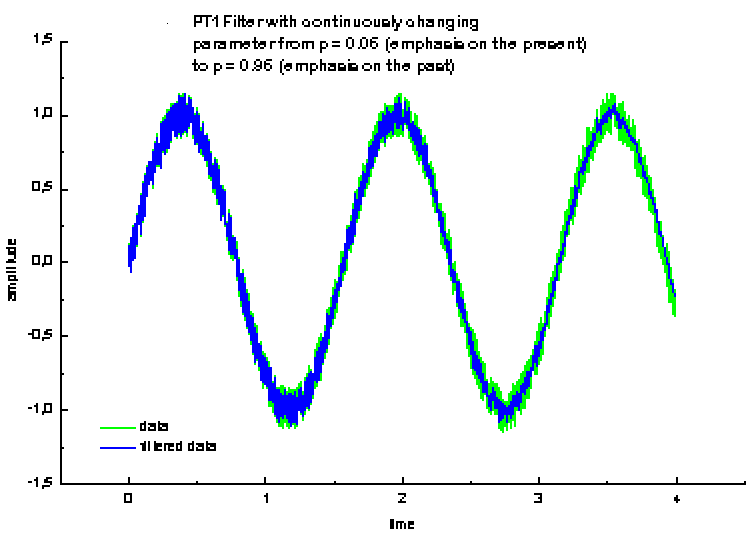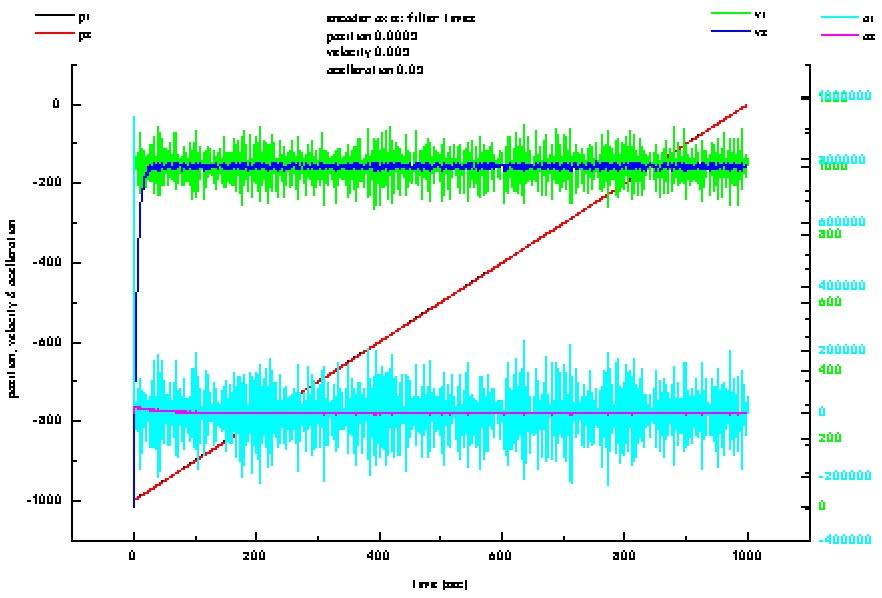Encoder
Depending on their operating modes, encoders determine the actual position, actual velocity or the actual acceleration. Actual values often fluctuate heavily, so a parameterisable filter is available for each mode in order to ensure a reasonable resolution. A wide variety of encoders versions is supported. Both absolute and incremental encoders are available. On top of this, there are simulation encoders and special encoders for the determination of force. The encoder parameters include the scaling, zero offset shift and the modulo factor. In addition, the encoder data includes the parameters for the software end locations and for the reference travel.
Interface
Every encoder that is not of the "simulation" type must be associated with an actual value acquisition module.
Encoder types
- Simulation encoders
- Absolute, with 24 or 25 bits, and 12 and 13 bit single turn encoders (M3000)
- Incremental, with 24 bits (M31x0, M3100, M2000)
- Incremental, with 16 bits (KL5101)
- Absolute SSI with 24 bits (KL5001)
- Absolute/incremental BISSI with 16 bits (KL5051 and PWM Terminal KL2502_30K (frq. cnt. pulse mode) )
- Absolute analog input with 16 bits (KL30xx)
- SERCOS "Encoder" POS
- SERCOS "Encoder" POS and VELO
- Binary incremental encoders (0/1)
- Absolute analog input with 12 bits (KL2510)
- T&R Fox 50 module (24 bits absolute (SSI))
- Force acquisition from Pa, Pb, Aa, Ab
- Incremental with 16/20 bits (AX2000)
- Incremental with 32 Bit
- Incremental with variable bit mask (max. 32 bits)
- Incremental NC backplane
Encoder parameters
Parameter | Data type | Unit | Description |
|---|---|---|---|
ENCODER mode | ENUM |
| Operation mode of the encoder: |
Encoder counting direction inverted | BOOL |
| Counting direction inverted: |
Scaling factor | float | mm/INC | Incremental evaluation: this factor is used to convert the displacement increments into axis positions. |
Zero offset shift | float | mm | With absolute encoders: this value is added to the encoder position in order to determine the axis position. It is used to specify the machine-dependent zero point. |
Modulo factor | float | mm | With rotary axes: this is the "distance" represented by one rotation. If the actual value is acquired, for instance, in degrees, 360.0 should be entered here. |
OPERATING MODE: min. end position monitoring | BOOL |
| Activation and deactivation of the monitoring of the minimum end position. |
Software end position, min. | float | mm | Location of the minimum end position |
OPERATING MODE: max. end position monitoring | BOOL |
| Activation and deactivation of the monitoring of the maximum end position. |
Software end position, max. | float | mm | Location of the maximum end position |
Actual position filter time | float>0 | s | Filter time for the PT1 filtering of the actual position. |
Actual velocity filter time | float>0 | s | Filter time for the PT1 filtering of the actual velocity. |
Actual acceleration filter time | float>0 | s | Filter time for the PT1 filtering of the actual acceleration. |
PT1 filter

A PT1 filter is a transfer function that performs convex interpolation between a new value xn and an old value (from one cycle ago) xa. The filter time parameter (>= 0.0) in seconds is to be entered. If l=Saf cycle time/(Saf cycle time+filter time), then x = l xn + (1-l) xa, l Î [0.0,1.0]. If the filter time is close to 0.0, the new value has a high weighting. If the filter time is long, the older value has relatively high weighting.

Referencing parameters
Parameter | Data type | Unit | Description |
|---|---|---|---|
Search direction for referencing cam inverted | BOOL |
| Search direction inverted: FALSE = cam is looked for in the direction of positive movement. TRUE = cam is looked for in the direction of negative movement. |
Search direction for sync pulse inverted | BOOL |
| Search direction inverted: FALSE = synchronization pulse is looked for in the direction of positive movement. TRUE = synchronization pulse is looked for in the direction of negative movement. |
Reference position | float | mm | The axis position that is assigned to the synchronization pulse that is active during homing. If the actual position of the axis is acquired in any unit other than mm, then that unit must be used here too. |
External sync pulse | BOOL |
| Reserved |
SERCOS Axes
The modulo scaling (only in the weighting of the position data in the modulo display (S-0-0076 bit 7)) determines the modulo value at which the position data begins again at 0. This value must agree with the value set at the drive (S-0-0103) if the position is to be correctly indicated and controlled.
When TwinCAT is active and SERCOS is at least in Phase 2, the value can be read off via "Calculate". Download and Upload can be used to write or read the value to and from the running TwinCAT system.